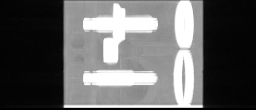



bane/gkms tutorial: Step 0: Preparing
the data
|
This tutorial does not work with any recent versions of Teem. Sorry.
|
It is often the case that a given volume dataset needs some
pre-processing before it makes sense to analyze or visualize it.
Cropping out large regions of background value is one common task,
which is demonstrated below, using the unu command-line utility.
There are many other things which
make sense as pre-processing steps in working with volume data
(down-sampling or re-sampling, quantizing, converting, etc), and
unu can do all of these. Try it out!
- The engine-block CT scan dataset is available from
Stanford's volpack related pages. Download the file
engine.den.Z and uncompress it, creating the file engine.den.
- engine.den contains the raw data we care about, plus
some binary header stuff we don't care about. Sounds like a job for
unu!
With one command, we can create a simple ASCII header file which
stays seperate from the data file, called (for
example) engine.den.nhdr.
We create it with:
unu make -h -i ./engine.den -t uchar -s 256 256 110 -sp 1 1 1 -c engine \
-bs 62 -e raw -o engine.den.nhdr
- "unu make" is the command for creating nrrd files from existing
data; "unu make -h" makes detached header files
- "-s 256 256 110": these are the dimensions ("sizes") of the
dataset.
- "-sp 1 1 1": these are the spacings for the samples; these
voxels are isotropic
- "-bs 62": there is a 62 byte binary header that we'll need
to skip over
This creates the following:
NRRD0001
content: engine
type: unsigned char
dimension: 3
sizes: 256 256 110
spacings: 1 1 1
data file: ./engine.den
encoding: raw
byte skip: 62
encoding: raw
- As you may already know, this dataset contains a lot of useless
background value. If we crop it out, all further analysis will run
raster, and the results (including the renderings) will be the same.
Sounds like a job for unu!
This use of unu project generates a maximum
intensity projection (measure #2) along the Z axis (axis #2) and Y
axis (axis #1) so that we can see how to crop it:
unu project -i engine.den.nhdr -a 2 -m max -o engine.den-maxZ.png

unu project -i engine.den.nhdr -a 1 -m max -o engine.den-maxY.png

- Inspecting the resulting images (with a tool like xv) tells us that the (x,y)
coordinates (59,207) and (20,227) encompasses all the interesting
stuff with about three voxels of border. In the Z axis, there is need
for cropping (in fact, it seems to have been a bit too aggressively
cropped already). If you want to indicate "the last index along this
axis", without knowing how big that axis is, you can use "M" instead
of a number. Thus, we invoke unu crop with:
unu crop -i engine.den.nhdr -min 59 20 0 -max 207 227 M -o engine-crop.nrrd
- We can verify that the cropping worked right, with another use of
unu project:
unu project -i engine-crop.nrrd -a 2 -m max -o engine-crop-maxZ.png

- Supposing that you don't want the nrrd header and the
raw data together in the same file, you break the file into two parts
simply by changing the output filename to end in ".nhdr", for
"nrrd header":
unu crop -i engine.den.nhdr -min 59 20 0 -max 207 227 M -o engine-crop.nhdr
The nrrdSave() function of nrrd interprets this
filename auto-magically, putting the header information in a small
ASCII file called "engine-crop.nhdr", while putting all the
raw data (with no header whatsoever) in seperate file called
"engine-crop.raw".
We now return to the rest of the tutorial ...








